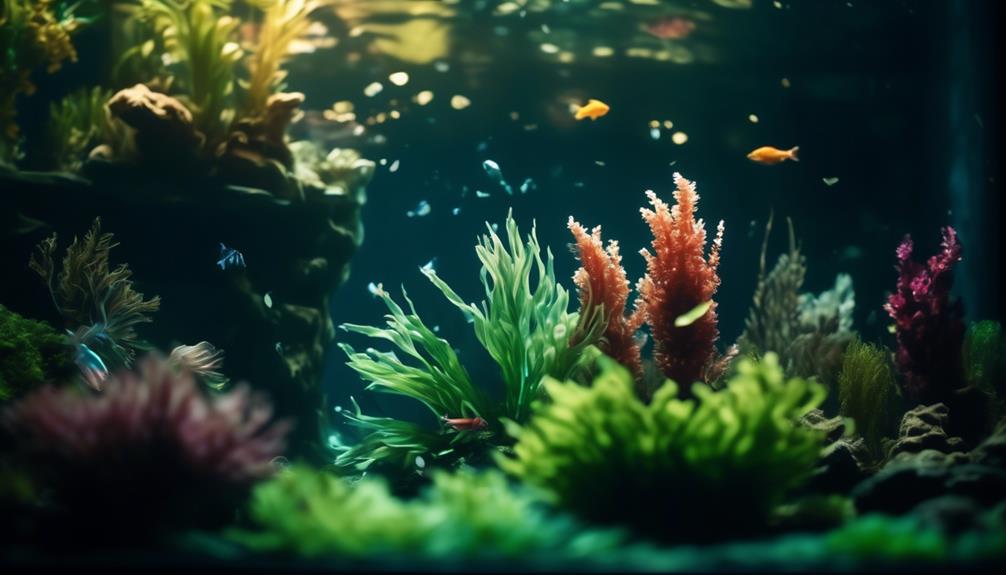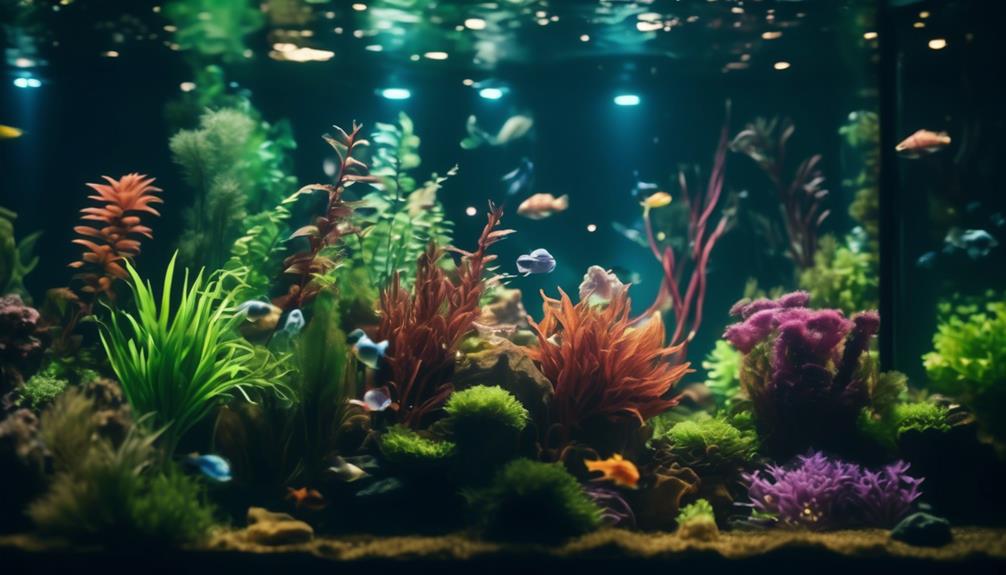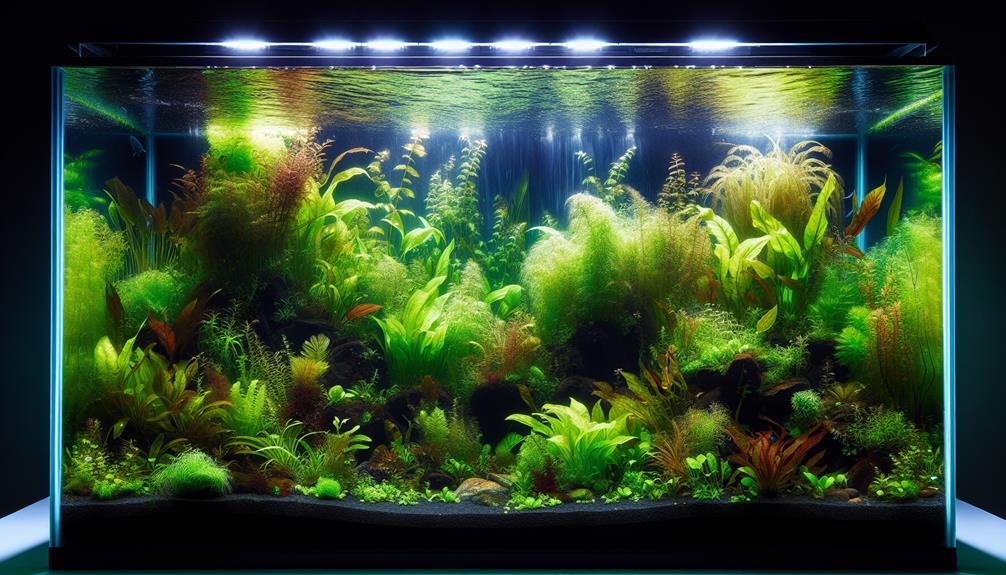Welcome to our informative discussion on finding the perfect aquarium light for thriving plants. As any aquarium enthusiast knows, providing the right lighting conditions is essential for the health and growth of your aquatic plants.
In this discussion, we will explore the key factors to consider when selecting an aquarium light, including color spectrum, light intensity, and light spread. By understanding these factors, you will be able to create an optimal environment for your plants to flourish.
So, let's dive into the world of aquarium lighting and uncover the secrets to enhancing the beauty of your aquatic ecosystem.
Key Takeaways
- Color temperature, measured in Kelvin, is an important factor in choosing the right aquarium light for thriving plants.
- Light intensity should be considered based on the type of plants you want to grow, with low, medium, and high lights being suitable for different species.
- Light spread is also a crucial aspect, with different aquarium lights having varying degrees of light coverage.
- When choosing the best aquarium light, it's important to consider your goals, budget, and the specific needs of your plants, and the Easy Plant LED by Aquarium Co-Op is a recommended option with adjustable brightness and a 5300 K color spectrum.
Color Spectrum and Kelvin
Color spectrum and Kelvin play a crucial role in determining the optimal lighting conditions for aquarium plants. Different color spectrums have varying benefits for plant growth. For instance, blue light promotes compact and dense growth, while red light encourages elongation and flowering.
The role of human preference also comes into play when choosing the color spectrum. Some aquarists prefer a more natural look, resembling sunlight, and opt for a neutral white light with a color temperature of 5000-6500 K. Others may prefer a more vibrant and visually appealing display, choosing lights with a higher color temperature.
Ultimately, the color spectrum should be chosen based on the specific needs and preferences of the plants and the aquarist.
Light Intensity and Plant Compatibility
Light intensity is a critical factor to consider when determining the compatibility of plants in an aquarium. The light intensity required for plants depends on their specific needs and growth requirements.
Low light intensity is suitable for undemanding plants, while medium light intensity is sufficient for most species. However, high light intensity is necessary for growing any type of plant, but it often requires additional CO2 injection to support their growth.
LED lights are recommended for their high brightness and energy efficiency. They provide the necessary light intensity for plants while minimizing energy consumption. By using LED lights, aquarium enthusiasts can ensure that their plants receive the optimal light intensity for thriving growth, while also being mindful of energy efficiency.
Light Spread and Aquarium Size

When considering the light spread in an aquarium, it is important to take into account the size of the aquarium and how far the light reaches. Maximum light spread refers to the distance the light can cover in the tank. It is crucial to ensure that the light coverage is sufficient for all the plants in the aquarium to receive adequate light.
Larger aquariums may require multiple lights to achieve optimal coverage. Some aquarium lights have a 120-degree light spread, which helps to distribute light more evenly throughout the tank. This is especially beneficial for larger aquariums or tanks with plants placed in different areas.
Ensuring proper light spread is essential for the overall health and growth of the aquatic plants in the aquarium.
Factors to Consider in Choosing the Best Aquarium Light
One crucial factor to consider when selecting the best aquarium light is to assess the specific light requirements of the plants in order to ensure optimal growth and health. Different plants have different light intensity needs, and it is important to choose a light that can provide the right amount of brightness. Additionally, budget considerations and adjustable brightness options are important factors to take into account. To help you make an informed decision, here is a table outlining some popular aquarium lights and their features:
| Aquarium Light | Adjustable Brightness | Price Range |
|---|---|---|
| Easy Plant LED | Yes | $50-$100 |
| Brightgrow LED | Yes | $80-$150 |
| Aqua-Glo Fluorescent | No | $20-$40 |
Consider your goals, budget, and the specific needs of your plants when choosing the best aquarium light for your setup.
Subscription Benefits for Aquarium Enthusiasts

Aquarium enthusiasts can greatly benefit from subscribing to receive weekly articles exploring various aspects of aquarium care and providing valuable insights to enhance their knowledge and skills in the hobby.
By subscribing, enthusiasts gain access to a wealth of information that can help them better understand the intricacies of aquarium care. These articles cover a wide range of topics, including water quality management, plant selection and maintenance, fish health and nutrition, and equipment recommendations.
Subscribers can stay updated on the latest trends and advancements in the field, ensuring that they are always equipped with the most current knowledge. This subscription service serves as a valuable resource for aquarium enthusiasts, allowing them to continually improve their practices and provide the best possible care for their aquatic ecosystems.
Frequently Asked Questions
How Does the Color Spectrum and Kelvin Affect the Growth of Aquarium Plants?
The color spectrum and Kelvin temperature of aquarium lights play a crucial role in the growth of aquarium plants. Different color temperatures can affect plant development, and choosing the right spectrum is important for optimal growth and health.
Can Low Light Intensity Affect the Health of Demanding Plants?
Low light intensity can negatively impact the health of demanding plants in an aquarium. Proper lighting is crucial for optimal plant growth, as it provides the necessary energy for photosynthesis and influences nutrient uptake and overall plant health.
What Are the Advantages of Using LED Lights in Aquariums?
LED lights offer several advantages for aquariums. They provide precise control over light intensity, have a long lifespan, and are energy-efficient. LED lights also offer a wide range of color spectrums, allowing for optimal growth of aquarium plants.
How Can I Determine the Number of Lights Needed Based on the Size of My Aquarium?
Determining lighting requirements and calculating light intensity for an aquarium involves considering the size of the tank and the light spread. By assessing these factors, one can determine the number of lights needed to ensure optimal conditions for plant growth.
Can You Provide Examples of Other Aquarium Lights That Offer a Wider Light Spread Than the Easy Plant Led?
Other aquarium lights that offer a wider light spread than the Easy Plant LED include the Finnex Planted+ 24/7, which has a 120-degree light spread, and the Fluval Plant Spectrum 3.0, which also offers a wider coverage area.
Conclusion
In conclusion, selecting the perfect aquarium light for your thriving plants is essential for their health and growth.
By considering factors such as color spectrum, light intensity, and light spread, you can create an optimal lighting environment for your aquatic ecosystem.
Remember to choose a light that meets the specific requirements of your plants and provides adequate coverage for your tank size and shape.
With the right aquarium light, you can enhance the beauty of your underwater world and ensure the vitality of your aquatic plants.

